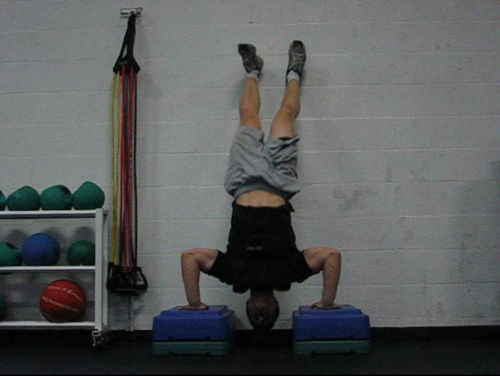Accommodating Resistance and the OAHSPU (one arm handstand pushup)
I don’t have a one arm handstand pushup yet, but I’ve been working towards it and seeing good progress. I wanted to talk about an exercise I’ve been using and the training concept of accommodating resistance as it applies to this and other bodyweight skills.
First off, accommodating resistance is the concept of changing resistance during the range of motion in order to sustain maximal force. This is done to overcome the fact that we are stronger at certain points of the range of motion than others. This is why you can quarter squat more weight than you can full squat. You’re stronger at the top of the motion. If you can change the resistance as the motion changes; accommodate it to account for the change in strength (due to better joint leverage), then you’ll work the muscles harder.
Accommodating resistance is nothing new at all. Powerlifters have been doing it for years with their bench, squat, and deadlift. Band and chain training adds or subtracts weight as the exercise is performed. It’s simple, yet very effective.
A big difference in the application of accommodating resistance for powerlifters vs. bodyweight enthusiasts is that powerlifters always use both arms (or legs) equally to move a weight and therefore need additional equipment (bands and chains) for the accommodation. For bodyweight enthusiasts, certain skills are performed with only one limb, and therefore the other limb can change the resistance for the pressing or pulling limb.
Below is a picture of an exercise I’ve been using for the OAHSPU – the assisted OAHSPU. This exercise has the advantage of being the most skill specific for the OAHSPU, namely that I’m upside-down. You’ll see that my assisting arm is elevated on a parallette. I found this to be useful as I could still use the assisting arm, even as I shifted my weight and balance over the pressing arm (the reason I’m leaning to the right).
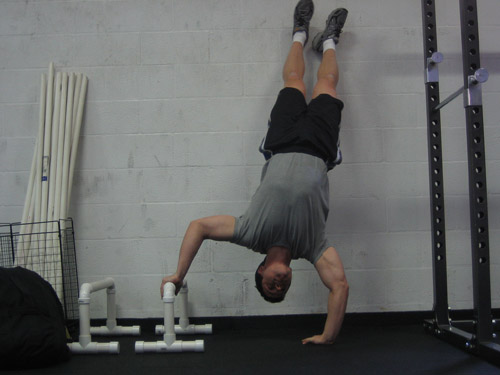
At the bottom of the movement, I’m using both arms to an equal degree, while near the top of the movement I’ve shifted weight to the pressing arm.
Now first let’s look at the force generated during a regular handstand pushup, it would look something like this:
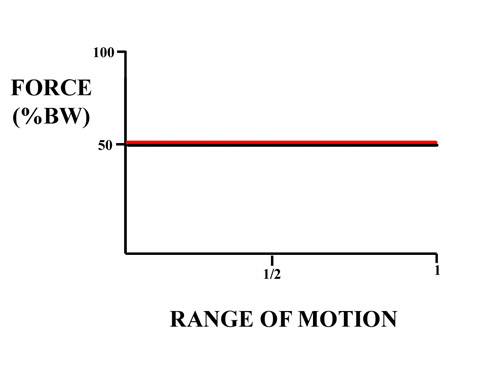
The red line represents the force one arm is producing (percent of bodyweight), while the black line is the force that the other arm is producing. Throughout the range of motion, the force remains constant. Each arm is pressing half of your bodyweight in order to lift you off the ground. The resistance is not accommodating.
While no accommodating resistance is present, we can still affect the X and Y axis by pressing on blocks (increasing range of motion) and adding weight (greater force needed).
During an assisted OAHSPU, the force curves look more like the graph below. The curves drawn are not mathematically calculated, but should give you a general idea of what I’m talking about.
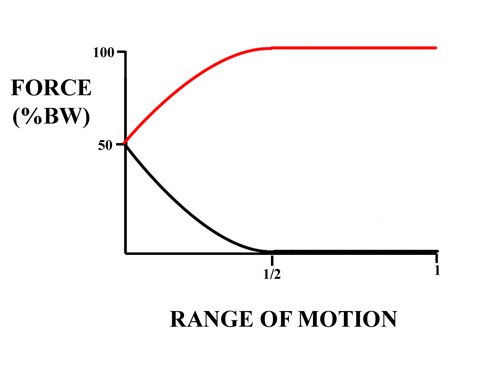
The red line represents the pressing arm, while the black line represents the assisting arm. Zero on the X-axis represents the bottom of the pushup. In other words, I’ve graphed the force curve as you press from the bottom to the top.
In the beginning of the press from the bottom, both arms may be exerting close to the same force, about half of bodyweight. But as we get closer to lock-out, things becomes easier due to better joint leverage, so we shift weight to the pressing arm. The pressing arm may take 100% of the bodyweight by the time you’re halfway through the range of motion. Our goal, of course, is for the pressing arm to take the entire bodyweight for the entire range of motion. That’s a one arm handstand pushup!
The assisted OAHSPU accommodates the resistance for the pressing arm so that it’s exerting the most force it possibly can for nearly the entire range of motion. This accommodation and change in the force curve is something that should happen automatically as you shift your weight off the assisting arm.
Now while the force curve on the previous graph is better than a regular handstand pushup, it has the problem of flatlining halfway through the range of motion. The pressing arm is pressing the maximal weight (your bodyweight) by the time it’s halfway through, but is it exerting maximal force the entire time? Perhaps not. Perhaps it could press a bit more weight near the top of the motion, but no more weight is available. This is solved through the use of a weight vest.
With the weight vest, pressing difficulty increases and the force curve for the pressing arm can continue to rise and accommodate for the entire range of motion. The dashed line in the graph represents your original bodyweight. Although the pressing arm only presses 100% of the force at the very end, it still presses more than your original bodyweight for a large portion of motion. This results in a greater amount of work for the muscles.
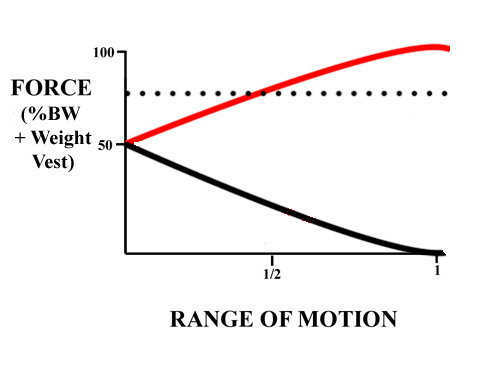
Keep in mind that adding the vest will also cause your assisting arm (black line) to word harder and longer during the exercise. Factor this in when planning rest periods for each arm.
By simply shifting the weight off the assisting arm as needed, and adding a weight vest if necessary, you can apply this concept of accommodating resistance to other unilateral bodyweight exercises such as the one arm chin, one arm pushup, and even the one arm front lever (weight shifts, although the force occurs during an isometric muscular contraction). These may be things you already instinctually do, but it’s good to understand the logic behind it.
Back to the OAHSPU, I’ve also been working heavy one arm shoulder presses in conjunction with the assisted skill. Reps no more than 3-5, and rest periods approaching two minutes. The shoulder presses have the advantage of full range of motion (hand all the way down to the shoulder). Taking the assisted OAHSPU to a full range of motion should prove useful in the future, but at the moment it’s a hard enough movement to focus on right now with the partial range.
Interesting to note that the assisted OAHSPU and one arm shoulder press seem to have a similar motion in that one needs to learn how to press off with the lat. A OAHSPU with just the shoulder and tricep would prove difficult, whereas learning to use the latissimus dorsi to stabilize the upper body helps tremendously with the skill.
Hope this wasn’t too much of a ramble and gives you some things to turn over in your head. Good luck with your training!


